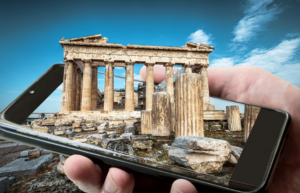Digital Cultural Heritage: Theory and Practice
27 أبريل 2024
The identification and interpretation of historical information and cultural value embedded in peoples’ heritage has become an essential and urgent requirement to form and strengthen national identities. As resources that have permanent value and importance, heritage must be protected and preserved for current and future generations because of its cultural, historical, aesthetic, archaeological, scientific, ethnological, or anthropological value for groups and individuals.
The role of cultural heritage does not end at its tasks to preserve and protect its material remnants. Cultural heritage must be invested in order to benefit the community. The past can serve the present. especially if heritage is managed with innovation and creativity, keeping pace with contemporary changes, and utilising available digital tools and technologies, such as 3D scanning, digital modeling, virtual reconstruction technology, holographic projection, enhanced reality, and 3D printing. Such technologies can create diverse cultural experiences that are easy to use without affecting the various material heritage elements, contributing to bridging communication gap between the past and the present, and between “things” and “people.”

The rapid developments in the fields of digital technology and artificial intelligence (AI) have resulted in revolutionary changes in the means of communication among people and the dissemination of knowledge. They have had an essential impact on traditional industries. Cultural heritage has not been immune from these developments and changes. New technologies provide smart tools to identify, protect, and share heritage, moving beyond traditional methods of heritage protection. However, these developments require a fundamental change in perspective on how we use cultural heritage, resulting in important questions, such as the extent of relationship between the protection of heritage and its use, selection of appropriate technologies, the types of services technology that can be used for heritage and its uses, and investment of technology to provide innovative services.
The answer to these questions will be somewhat complicated, but it is based on a simple principle. We must refer to the original concept of heritage preservation, which is “preserving identity and protecting history and traditional culture”.
Digital heritage is a new concept that has emerged in the digital age. It refers to unique resources and information of long-term value and importance produced by digital means. It also refers to the merging of cultural heritage with digital technology. Digital heritage not only includes the three traditional aspects of cultural heritage, – collection and documentation, research and information management, presentation and interpretation but also the creation and use of digital content. Digital heritage content consists of a wide and growing range of formats such as texts, databases, still and moving images, audio, graphics, software, and web pages, which are produced according to specific procedures, controls, standards, and specifications, and require permanent management and maintenance to preserve them for the longest possible time.
Procedures of digital cultural heritage includes three different stages, namely internal storage, network sharing, and interaction regarding content. Work of digital cultural heritage is divided into three parts – digital documentation, research management, as well as presentation, visualisation, and interpretation. Digital documentation and recording techniques include remote sensing, photogrammetry/image modeling, 3D laser scanning, infrared/multi-spectral image exploration, underwater exploration. Digital management technology research covers matters of disaster prevention and control, monitoring and protection, computer simulation, and database analysis/information management platforms such as BIM. Digital presentation/visualisation and digital interpretation includes web/interactive web creation, 3D modeling, processing and animation, Light / Projection / Holographic, Virtual Reality/Augmented Reality.
Cultural heritage and digital technologies are viewed as interconnected entities, where there is no relationship of dependency to any party at the expense of the other. This complementary relationship can create unique products that blend national cultural heritage with contemporary developments and changes. Digital technologies bring about several features, including flexibility, dissemination, and multi-use, which contributes to the dissemination of national culture around the world. This is on top of the protection of original and rare collections, sharing of resources and information, and adding value to original materials. Digital technologies also strengthen the educational function of cultural heritage, as it creates a heritage culture with modern perspectives and dimensions that encourages wider participation. It also provides more opportunities for cultural heritage research, communication, education, training and participation. The success of digital cultural heritage projects can be achieved by developing a framework that outlines the main activities, standards, and best practices, as well as the availability of a human component who is aware of heritage and its significance and has the necessary skills and experience in the field of design and information technology.

There are several advantages and benefits of using digital technologies in the field of cultural heritage. Examples include the possibility of using smart applications to display elements of heritage in a modern and interactive manner, digitising and making available heritage assets, collecting data on customs, traditions, activities, buildings, sites, and other legacies, promoting awareness, creating experiences in field of heritage, and providing a heritage experience through virtual exhibitions, mobile applications, and social media.
The ultimate objective of digital heritage is to provide a platform to facilitate communication among various cultural, academic sectors, and society at large. This allows institutions and experts in digital technology, archaeology, museology, library, history, architecture, and other related fields to exchange ideas and promote activities related to research, interpretation and visualisation, thereby advancing the development of the local and global digital heritage industries.
Contributed by Ahmed Adel Zidan, Library Director, University of Khorfakkan, UAE